Being young is to love Joni Mitchell's music. Growing older is to understand why you do.
I had an enormous crush on this Nordic beauty four years my elder (high cheekbones and bangs, oh my!)
as she broke out of the folk scene in the late 1960s and delivered a series of great albums, each one better than the next and peaking with Hejira that mirrored our more or less parallel lives of loving hard and living high, much of the time on the road.
That crush evolved into a deep if non-romantic love as Joni moved away from her cycle of self-discovery albums into a series of audacious explorations like Don Juan's Reckless Daughter, Mingus and Shadows and Light that confounded her fans and flummoxed many critics.
Joni was hospitalized on Tuesday and underwent surgery after being found unconscious in her longtime home in Bel-Air, a Los Angeles suburb. At age 71, she has grappled for years with what she describes as "a survival blur" of health issues, has had a well deserved case of the ass concerning how aging woman celebrities are judged differently than men, and has made few public appearances. She was inducted into the Rock and Roll Hall of Fame in 1997 and released the four-disc retrospective set Love Has Many Faces last year, which includes liner notes in which she reprises a longtime grumpiness about Bob Dylan and David Geffen.
The outlines of her career are well known: Growing up in nowheresville Saskatchewan to busking on the streets of Toronto to the Greenwich Village folk scene to beyond hip SoCal singer-songwriter to pop and jazz diva.
The back story is far more interesting.
Sussing out the currents in Joni's life and connecting them to her music is a daunting undertaking. And forbidding because while Joni has spoken over the years about how her life and loves stoked her creative fires, she has left much for us to speculate on while tending to rewrite her own version of certain events when what may have happened didn't square with her self image.
Meanwhile, Joni taught me a most valuable and lasting lesson not just about her but all musicians.
At several turns in her career she went places that I didn't want her to go because I was content with where she was. But after Hejira she and I made a deal: If I trusted her I would be amply rewarded. And so I have been.
* * * * *Would it have been possible for Roberta Joan Anderson nee Mitchell to become one of the greatest singer-songwriters of the latter part of the 20th century had she grown up a level-headed young women in a liberal household, was encouraged by parents and siblings to pursue her muses, graduated from college, married her high
school sweetheart, got a day job and had a slew of children?
Of course not.
As it was, Joni was raised as an only child in an exceedingly conventional and conservative household, contracted and overcame polio at the age of nine, took up smoking before she was in her teens (and never quit), showed early signs of her notoriously bad temper, and began singing.
She taught herself ukulele and later guitar and began performing at parties, which led to busking and coffeehouse gigs in Saskatoon. After finishing high school, she attended the Alberta College of Art and Design in Calgary for a year, but against her mother's wishes announced that she was going to Toronto to be a folksinger. But there was another reason, as well. Joni was pregnant by her former college boyfriend and unbeknownst to her parents and most friends, gave birth to a baby girl at a Toronto charity hospital in February 1965 whom she named Kelly Dale.
The baby was put into foster care while Joni decided what to do. A few weeks after the birth, she married folksinger Chuck Mitchell and took his surname. Although he says that he promised to help be
responsible for Kelly Dale, she gave her up for adoption. Joni herself has polished this event to a "Chuck Made Me Do It" shine in repeated tellings over the years, but I tend to go with him on this one because even back then Joni was the mistress of her destiny.
In any event, giving up Kelly Dale was a deeply painful experience alluded to in a few of her songs but remained a secret until it was finally but only obliquely referred to in "Chinese Cafe/Unchained Melody" on Wild Things Run Fast in 1982. (Mother and child were reunited 32 years later in 1997.)
Sheila Weller writes in Girls Like Us, an insightful if hyperventilative 2009 book on Mitchell and fellow singer-songwriters Carole King and Carly Simon, that an aftertaste of the decision to give up her child can be seen in the piercing quality of Joni's songs, from the faintly panicked earnestness in her first two albums to the defenselessness of Blue. Today it's a career boon for an edgy young performer to be with child; today, magazines burst with expensively
acquired photos of unmarried stars: pregnant, pushing toddlers in strollers, or both. This was not the case in 1975.
Joni's growth outpaced Chuck Mitchell's and her songs began catching on. Even her earliest compositions like "Urge For Going," which she wrote in 1966, have a cliché-free sophistication.
Among the musicians who noticed this were folk singer Tom Rush, who took "Urge For Going" to folk superstar Judy Collins, who wasn't interested. Rush recorded the song himself, and then George Hamilton IV, who had a country hit with his cover version.
* * * * *
Joni's own urge for going became overpowering, and in early 1967 she ditched Mitchell and moved to New York City to launch a solo career that from the outset was helped enormously by the popularity of her earliest songs among the headliners she hoped to emulate. These included Fairport Convention, Buffy Sainte-Marie, Dave Van Ronk and eventually Collins, who had a huge hit with "Both Sides Now."
Joni rented an apartment in Chelsea and set out on the East Coast folk circuit.
She soon met David Crosby at a show in Coconut
Grove, Florida. Crosby, who had just fired himself from the enormously popular The Byrds (or the other way around, depending on who tells the story), was the first of a long line of talented and well-connected musicians and producers that Joni would bed, sometimes live with and, in two instances after Mitchell, would marry. (Crosby was still a few months away from his collaboration with Graham Nash, one of Joni's future lovers, and Stephen Stills, and later Neil Young, with whom she would briefly live.)
It is hugely unfair to suggest that these trysts were merely in the service of advancing Joni's career, although they certainly didn't hurt her professionally. More accurately, Joni led with her heart and her head eventually would catch up.
Crosby took Joni back to Los Angeles where he introduced her to his extensive circle of music industry friends and talked the Reprise label into not only recording a solo acoustic album but giving her artistic control, something that was unheard of for a woman artist back then but she has insisted on having
throughout her career.
Song to a Seagull was released in March 1968 to a warm reception and Joni's continuous touring quickly created a buzz for Clouds, which was released to good reviews in April 1969. It contained her own versions of "Both Sides Now" and songs recorded by others, including "Chelsea Morning," which young Yale law student Hillary Rodham loved so much that she and fellow student Bill Clinton named their daughter after it.
Clouds earned Joni her first of eight Grammy Awards in March 1970. The following month, Ladies of the Canyon was released, received widespread FM radio play and became her first gold album.
For the Roses, her fifth album, was released in October 1972, and included her first hit single, "You Turn Me On, I'm a Radio." Court and Spark followed in January 1974, and spawned two hit singles, "Free Man in Paris" and "Help Me," which became Joni's only Top 10 single when it peaked at number 7.
Miles of Aisles, a two-disk live album, was released in November 1974 and like Court and Spark also topped out at No. 2 on the Billboard chart. Joni had recorded
the album earlier in the year while on tour with Tom Scott's L.A. Express, a jazz-pop band that she had sought out to broaden her musical palette. The band included drummer John Guerin, who became another of her lovers.
The Hissing of Summer Lawns, an allusion to the sprinklers on the lawns of the mansions in her Bel Air neighborhood, was released in November 1975 and climbed to No. 4, but was panned and unfairly so. Joni was starting to move away from her young womanish confessionalism and the critics were having trouble keeping up.
* * * * *
In early 1976, Joni traveled cross country to Maine with friends. Donning a red wig and renaming herself "Charlene Latimer," she drove back to L.A. alone in a rented Mercedes convertible, writing most of the songs for Hejira as she traveled.
This ninth and most realized of her 27 albums -- with its riot of open tunings, complex harmonies, tensions and releases and stunning visual imagery, as well
as the eclectic electric bass guitar stylings of Jaco Pastorious -- was released in November 1976 and broke the Top 20.
Weller writes:
The long trip seemed to highlight how out on a limb she'd chosen to climb. As with more than a few other women in their mid-thirties, the indecisiveness that had started as a temporary principled rebellion had become her life. Six years ago she'd journeyed through Europe – sleeping in Malta caves and Ibiza fincas – to shake off a relationship with Graham [Nash]. Now in shaking off John [Guerin], cold-water interstate rest rooms, blue motel rooms, and Winn-Dixie cold cuts formed the starker backdrop and sustenance for her advanced reflections.
In the summer of 1977, Joni began work on what would be her first studio double album and her most daring in that it was completely jazz based. When Don Juan's Reckless Daughter was released in December 1977, it received mixed reviews. Janet Maslin of The
New York Times dubbed it "Joni Mitchell's Reckless and Shapeless Daughter" and wrote that this "failure" showed that:
Mitchell appears bent on repudiating her own flair for popular songwriting, and on staking her claim to the kind of artistry that when it’s real doesn't need to announce itself so stridently.
Such reviews wounded Joni, who for all her determined independence wanted her fans to love her and the critics to appreciate her, but she plowed ahead and in late 1978 received a career- and life-altering call from Sue Graham Mingus, the wife of legendary jazz composer and bassist Charles Mingus.
Mingus, who was wheelchair bound and in the final stages of amyotrophic lateral sclerosis, had been so taken by Joni's foray into jazz that he wrote six melodies flatteringly titled "Joni I" to "Joni VI." Mingus' wife asked whether she would be interested in writing lyrics for them.
Joni composed the words for four of the pieces with Mingus before he died in January 1979 and finished
the other two later. She then recorded the album Mingus with a who's who of sidemen, including Pastorius, drummer Don Alias (her lover at the time), keyboard innovator Herbie Hancock and sax virtuoso Wayne Shorter.
Critics were befuddled – and generally critical -- after the album's November 1979 release, and it "only" reached No. 17. But Joni knew exactly what she was doing, telling Cameron Crowe in a Rolling Stone interview:
You have two options. You can stay the same and protect the formula that gave you your initial success. They're going to crucify you for staying the same. If you change, they're going to crucify you for changing. But staying the same is boring. And change is interesting. So of the two options, I'd rather be crucified for changing.
* * * * *I have nothing against Joni's later career, which abruptly if temporarily ended in an angry outburst in 2000 when she declared that what passed for commercial radio fare was slop (generally true) and she couldn't get a hearing (entirely true).
Not long after she unretired to record for the Starbucks chain label, but she had made a larger point: Eric Clapton could grow old and look old but remain "vital" in the eyes of critics, but Joni Mitchell was not allowed to do either and everything she did would be incessantly compared to her early work.
Except for a few albums, Night Ride Home (1991) and Turbulent Indigo (1994) chief among them, my head and heart remain happily stuck in the amazing creative burst that took the squeaky voiced girl from the plains of Saskatchewan through Song to a Seagull to the husky voiced chanteuse of Mingus.
At the end of the day, there is no compliment greater than to be called a "musician's musician," but what is so extraordinary about Joni is her songs are so powerful that early on musicians were drawn to them before she had even recorded them herself.
She is an ultimate musical category breaker, and artists as disparate as Tori Amos, Elvis Costello, Madonna, Bjork, Prince, Morrissey, and Counting Crows, which had a big hit with her "Big Yellow Taxi," to name but a few, have been moved and influenced by her. But River: The Joni Letters, a 2007 Herbie Hancock album covering nine of her songs that was a surprise Grammy winner, is to my ears the ultimate tribute.
To hear Norah Jones sing "Court and Spark" with the accompaniment of Hancock, Wayne Shorter and Dave Holland, as well as other sidemen, is to hear Joni all over again for the first time.
But it is Luciana Souza singing "Amelia" that best sums up Joni Mitchell for me:
The drone of flying engines
Is a song so wild and blue
It scrambles time and seasons if it gets through to you
Then your life becomes a travelogue
Of picture-postcard-charms
Amelia, it was just a false alarm
ALBUM COVERS (Top to bottom): Song to a Seagull (1968), Clouds (1969), Ladies of the Canyon (1970) For the Roses (1972), Court and Spark (1974), The Hissing of Summer Lawns (1975), Hejira (1976), Don Juan's Reckless Daughter (1977), Mingus (1979), Night Ride Home (1991), Turbulent Indigo (1994), The River: The Joni Letters (2007), Love Has Many Faces (2014).



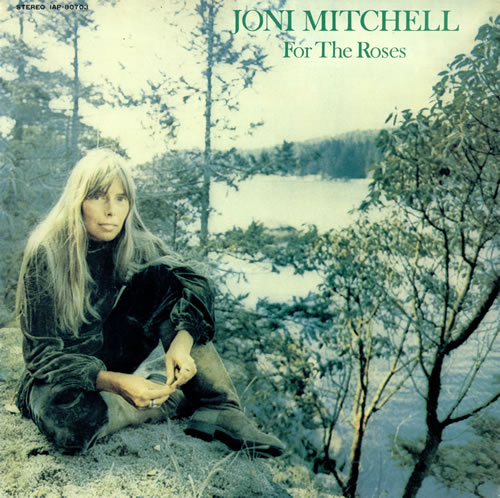
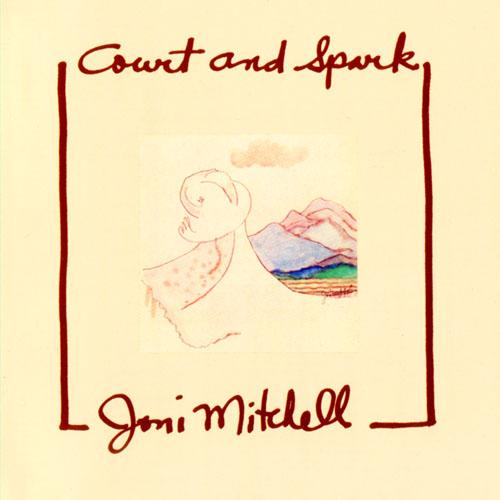


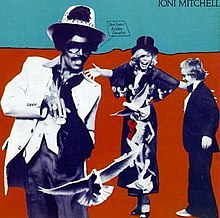

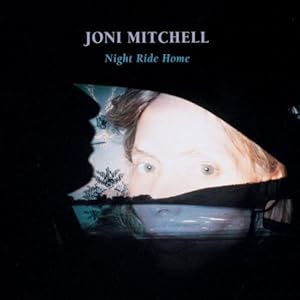

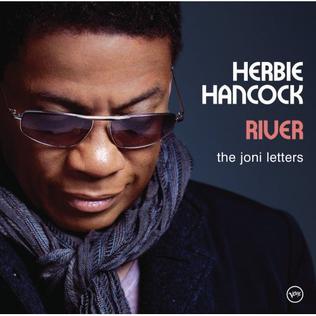

2 comments:
A compelling summary of a wide-ranging and complex career, but are you sure you ain't counting her out before she's quite gone? I saw in the LAT that she's alert and "in good spirits" after surgery, if that's to be countenanced with her. And you might stick in a mention of "Blue," still my favorite!
You followed her down her chosen path in much the way I have with Dylan's twists and turns (though I never much cottoned to the Bible-thumper Bob. I never could quite get to her modern jazz pathway, but I'm slow on that front with just about all the purveyors, even Miles and 'Trane. I prefer their explorations of the music roots and melody, not so much the electronic forays or anything arhythmic or atonal.
Maybe that's why I'm spending much of my eves these days tracking back to the originals at the birth of New Orleans jazz, pre-Louis back to Buddy Bolden (never recorded) and Kid O'ry, Sidney Bechet and Jelly Rolly Morton (who were), and then forward to Clarence Williams, Fletcher Henderson, Jack Teagarden and Wild Bill Davison. I guess I'm regressing, but I apparently missed those chapters in my musical adolescence.
But back to Joni, it's perhaps unfair of me in considering a creative artist, but her prickly attitude and hypersensitivity to real & imagined slights turn me away from much of her oeuvre that I might actually have appreciated. It's not gender-based; I'll shun almost anybody (save Dylan and maybe Lennon) who I perceive to be personally an obnoxious shit. It's like patronizing an establishment where the proprietor regularly maligns customers, which I refuse to do. I don't want to do anything to encourage that!
Joni may surely have had her reasons for pouting and preaching, but it seemed after a while to all but take over her persona -- and her music, or at least her lyrics. Still, the art from her earliest work, as you note, and, for me, on through "Blue," "Court and Spark" and ultimately "Hejira" were wondrously and uniquely musical, intimate and poignant. After that, I think I just lost interest in her worldview, notwithstanding the Pastorius and Mingus linkage, and let her pursue her future while I looked for mine. May she recover well, and with renewed joie de vivre.
She was never my favorite. Thought a bit too elitist...if that's the right word. I tried, I did. But music, even if your best friend loves it, is so personal and Joni and I never connected like Bonnie and I did. Your blog is special, though, and gave me insight which I'm sure was your intention to all who read it. I could read you all day, my friend...Anything. Perhaps your slant on the phone book or lack of it. Doesn't matter. Write on!
Post a Comment